The double rear doors are fitted with a catch which stops the opening at an angle of approximately 90∞.
![]() The catch system is designed to ensure the best comfort in use. An accidental
knock or gust of wind could release the doors and make them close.
The catch system is designed to ensure the best comfort in use. An accidental
knock or gust of wind could release the doors and make them close.
It is possible to increase the opening angle of the two doors to facilitate loading and unloading operations. Force the doors open. This will allow opening the doors by approximately 180∞.
![]() When open to 180∞, the doors are not blocked. Do not use this system when
the vehicle is parts on a slope or when it is windy.
When open to 180∞, the doors are not blocked. Do not use this system when
the vehicle is parts on a slope or when it is windy.
Opening the first door from the outside 1-fig. 114
Turn the key to position 2-fig. 115 and pull the door handle in the direction of the arrow.
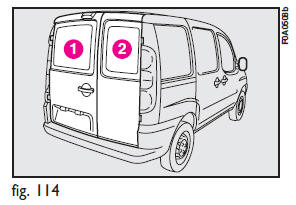
Turn the key to position 2-fig. 115 and pull the door handle in the direction of the arrow.
Closing the first door from the outside 1-fig. 114
Turn the key to position 1-fig. 115.
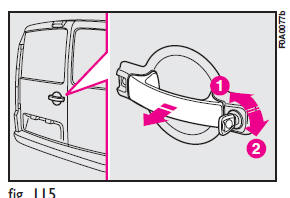
![]() Close the right-hand door 2-fig. 114 completely first and then close the left-hand
door 1-fig. 114. Never close both doors at the same time.
Close the right-hand door 2-fig. 114 completely first and then close the left-hand
door 1-fig. 114. Never close both doors at the same time.
Opening the first door from the inside 1-fig. 114
Lift lever A-fig. 116 in the direction of the arrow.
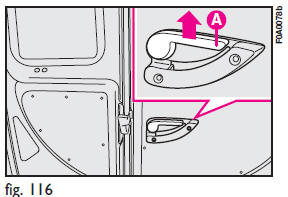
Opening the second door 2-fig. 114
After opening the first door, pull handle A-fig. 117 in the direction of the arrow.
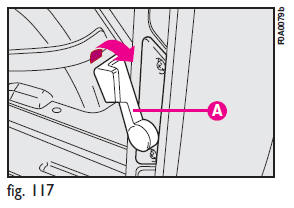
IMPORTANT
Only use the handle A-fig. 117 in the direction shown in the figure.
The swing doors (where provided) are fitted with a device A-fig.117a that limits their opening.
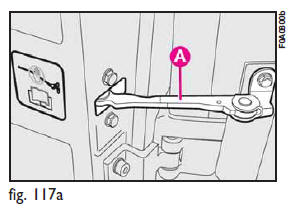
Take care not to move the rod from its housing; if it is moved by accident
 fig. 117b, restore it to the correct
position
fig. 117b, restore it to the correct
position  fig. 117b.
fig. 117b.
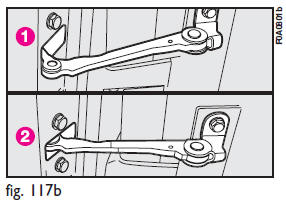
See also:
Quick heating
Proceed as follows:
❒ close all dashboard vents;
❒ turn knob (A) to ;
❒ turn knob (C) to 4 ;
❒ turn knob (D) to . ...
Adjusting the front seat belt height
Make the height adjustment when the vehicle is stationary.
Always adjust the height of the seat belt to fit the person wearing it. This
could greatly reduce the risk of injury in the case of colli ...
Tire Chains
Use only compact chains, or other traction aids that meet SAE type УClass SФ
specifications. Chains must be the proper size for the vehicle, as recommended by
the chain manufacturer.
NOTE: Do no ...


